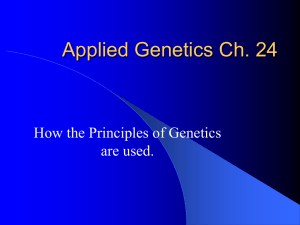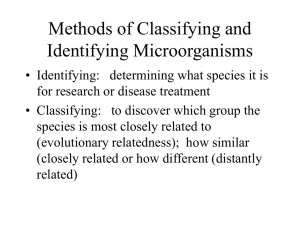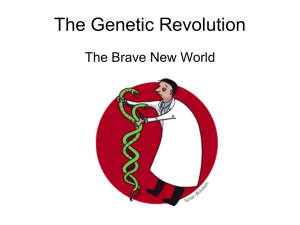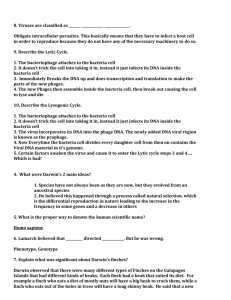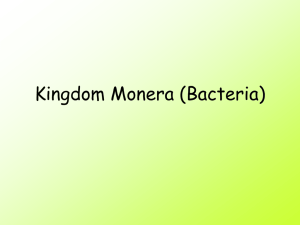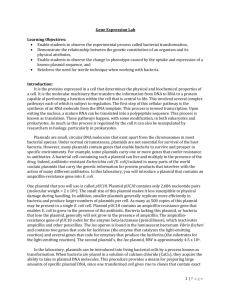IB Biology Year 1 KEY to the MolecuLab 115 Student Manual: Q`s for
advertisement
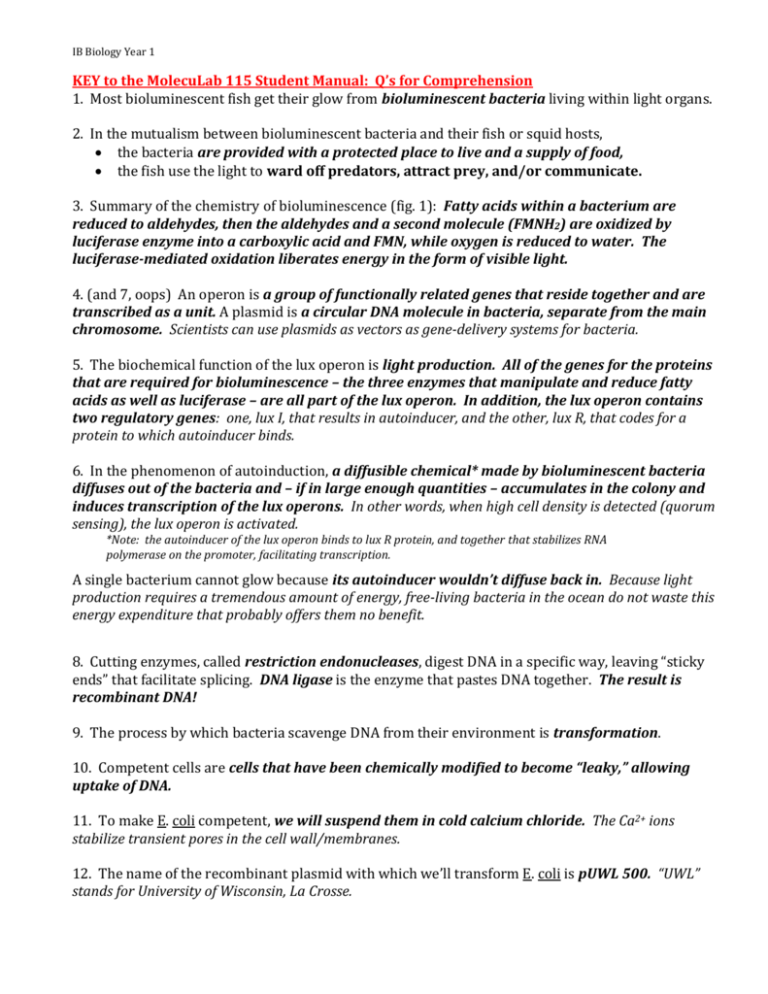
IB Biology Year 1 KEY to the MolecuLab 115 Student Manual: Q’s for Comprehension 1. Most bioluminescent fish get their glow from bioluminescent bacteria living within light organs. 2. In the mutualism between bioluminescent bacteria and their fish or squid hosts, the bacteria are provided with a protected place to live and a supply of food, the fish use the light to ward off predators, attract prey, and/or communicate. 3. Summary of the chemistry of bioluminescence (fig. 1): Fatty acids within a bacterium are reduced to aldehydes, then the aldehydes and a second molecule (FMNH2) are oxidized by luciferase enzyme into a carboxylic acid and FMN, while oxygen is reduced to water. The luciferase-mediated oxidation liberates energy in the form of visible light. 4. (and 7, oops) An operon is a group of functionally related genes that reside together and are transcribed as a unit. A plasmid is a circular DNA molecule in bacteria, separate from the main chromosome. Scientists can use plasmids as vectors as gene-delivery systems for bacteria. 5. The biochemical function of the lux operon is light production. All of the genes for the proteins that are required for bioluminescence – the three enzymes that manipulate and reduce fatty acids as well as luciferase – are all part of the lux operon. In addition, the lux operon contains two regulatory genes: one, lux I, that results in autoinducer, and the other, lux R, that codes for a protein to which autoinducer binds. 6. In the phenomenon of autoinduction, a diffusible chemical* made by bioluminescent bacteria diffuses out of the bacteria and – if in large enough quantities – accumulates in the colony and induces transcription of the lux operons. In other words, when high cell density is detected (quorum sensing), the lux operon is activated. *Note: the autoinducer of the lux operon binds to lux R protein, and together that stabilizes RNA polymerase on the promoter, facilitating transcription. A single bacterium cannot glow because its autoinducer wouldn’t diffuse back in. Because light production requires a tremendous amount of energy, free-living bacteria in the ocean do not waste this energy expenditure that probably offers them no benefit. 8. Cutting enzymes, called restriction endonucleases, digest DNA in a specific way, leaving “sticky ends” that facilitate splicing. DNA ligase is the enzyme that pastes DNA together. The result is recombinant DNA! 9. The process by which bacteria scavenge DNA from their environment is transformation. 10. Competent cells are cells that have been chemically modified to become “leaky,” allowing uptake of DNA. 11. To make E. coli competent, we will suspend them in cold calcium chloride. The Ca2+ ions stabilize transient pores in the cell wall/membranes. 12. The name of the recombinant plasmid with which we’ll transform E. coli is pUWL 500. “UWL” stands for University of Wisconsin, La Crosse. IB Biology Year 1 13. The two sources of DNA “cut and pasted together” to make pUWL 500 were pGEM plasmid DNA, sold by a biotech company (Promega), & genomic DNA from Vibrio fischeri (i.e., the lux operon) Both the plasmid and the V. fischeri DNA were cut with a restriction enzyme called Sal I. Sal I was the first restriction enzyme isolated from Streptomyces albus bacteria. 14. The gene to resist ampicillin was included in our recombinant plasmid for screening. In other words, only transformed bacteria would possess the ampicillin resistance gene enabling them to live in the midst of agar with ampicillin. 15. DH5-alpha is classified in Biosafety Level 1, the level with the least risk . According to Wikipedia, BSL1 is for “… work involving well-characterized agents not known to cause disease in healthy adult humans, and of minimal potential hazard to lab personnel and the environment.” My MolecuLab Teacher’s Manual states that DH5-a doesn’t make restriction enzymes, cannot “have sex with” other bacteria, and is a fragile strain that needs rich agar to grow, decreasing the likelihood of survival outside the lab. BSL1 Precautions include wearing gloves and some sort of facial protection using separate waste receptacles for contaminated materials washing one’s hands with anti-bacterial soap washing all exposed surfaces of the lab with disinfectants being supervised by someone with general training in microbiology
